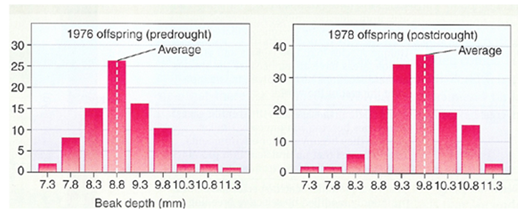When Hairston, Smith, and Slobodkin suggested that the earth is green because carnivores depress the populations of herbivores that would otherwise consume most vegetation, they were focusing on __________ control of community structure.
A) top-down
B) bottom-up
Ans: A) top-down
You might also like to view...
Peter and Rosemary Grant study natural selection in finches on the Galápagos Islands. They have hypothesized that dry condition produce larger seeds and may result in larger beaks in succeeding generations of finches. The figure below shows their data from 1976 and 1978. The y-axis is the number of birds measured and the x-axis is the beak depth. Do their data support their hypothesis and why?

A. Yes; because there were more birds measured in 1978 after the drought, therefore they must have been able to get food and reproduce.
B. Yes; because the average beak depth of birds in the population increased from 8.8mm in 1976 to 9.8mm in 1978.
C. No; because even though more birds were measured in 1978, the beak size of the upper range was smaller.
D. No; because in 1976, before the drought, the largest beak depth was still 11.3mm.
E. No; more data would be necessary to show a support of their hypothesis.
__________ are jawless fishes with a backbone. Fill in the blank(s) with the appropriate word(s)
Which statement about the blending concept of inheritance is correct?
A. A cross between a tall man and a short woman can produce some children that are tall while others are short. B. Genetic material is unstable which accounts for such a wide diversity in our offspring. C. A cross between a tall man and a short woman produces tall children who can then produce short grandchildren. D. A cross between a tall man and a short woman would always produce children of medium height.
Although it contributes no cells to the embryo, this structure guides the formation of the primitive streak:
A) endoderm B) mesoderm C) ectoderm D) neural crest E) hypoblast